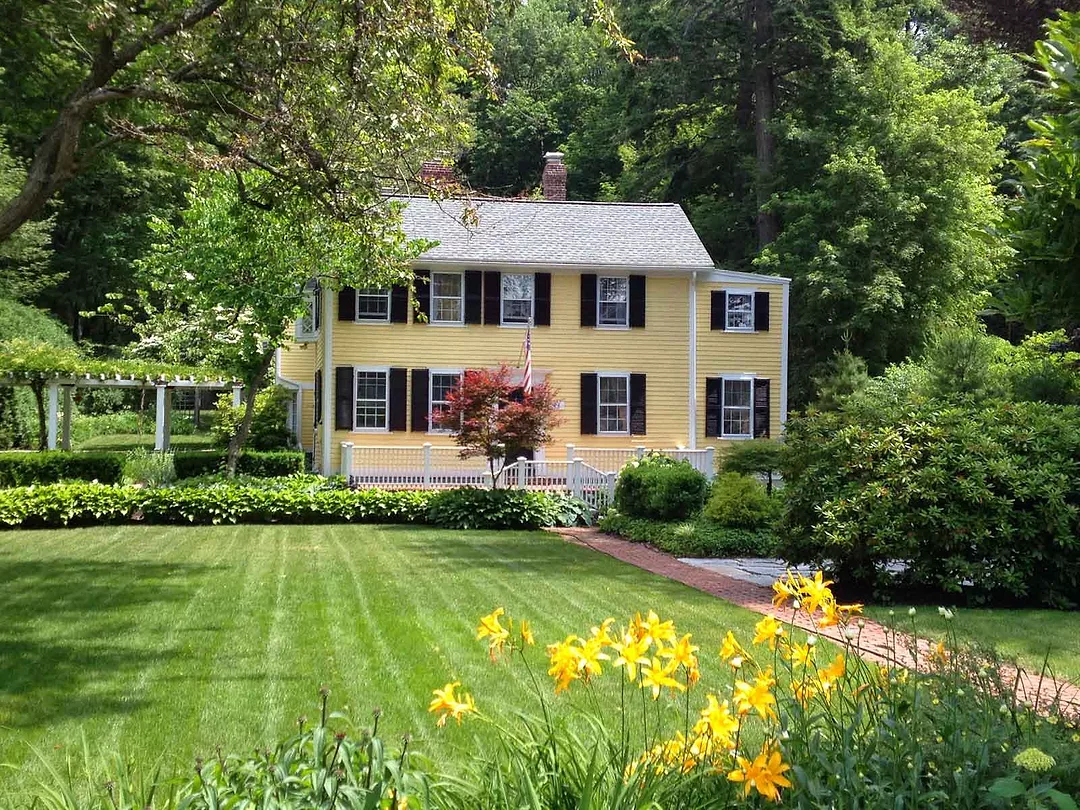Few places in the United States offer a wealth of history, literature, anthropological clues, and examples of early American architecture along a one-mile stroll. Concord’s American Mile invites you to enjoy the great outdoors while learning about the town’s fascinating history. Begin your adventure at Monument Square and head east along Lexington Road.
1 Founded in 1716, Concord’s Colonial Inn (48 Monument Square) is an American landmark and played an important role in the events leading up to the American Revolution. The Concord minutemen stored arms and provisions here, and parts of the Inn served as a makeshift field hospital, operating room, and morgue during the battles of April 19, 1775.
In 1835, John Thoreau moved his family into the Inn, including his son, Henry David Thoreau, who was attending Harvard College at the time. The Inn, which had consisted of three separate buildings, was converted into a single, connected structure and began operating as a hotel in 1889. Over the years, Concord’s Colonial Inn became recognized for its hospitality and welcomed as guests some of the most celebrated people of their times, including J.P. Morgan, John Wayne, President Franklin Delano Roosevelt, and members of the Kennedy family.
2 Since its construction in 1851, Concord’s Italianate Town House (22 Monument Square) has served as a center of social and political life. Many of Concord’s leading thinkers spoke or led important events here, including Ralph Waldo Emerson and Bronson Alcott. The abolitionist John Brown spoke here in March of 1857 and again in May 1859, where he raised $2,000 for his cause from Concordians - including Ralph Waldo Emerson, Henry David Thoreau, and Bronson Alcott. When Brown was tried and executed following his raid on Harpers Ferry, Concord held a memorial service for him here in the Town House.
3 Monument Square holds many clues to important moments in Concord’s history. Look for the marker of Jethro’s Tree near the Mill Brook, where an agreement was struck between the Indigenous people living here and the colonists who would later transform these lands into a town.
A small, obscure plaque marks the spot where Henry David Thoreau spent the night in jail for refusing to pay taxes that he felt were enabling the enslavement of people via the Fugitive Slave Act. His time in jail inspired him to write the paper that would become known as “Civil Disobedience;” a text that would later inspire the use of nonviolent protest by leaders such as Mahatma Gandhi and Dr. Martin Luther King, Jr.
You will also find a large obelisk with the names of most of Concord’s heroes who fell in the Civil War. One name is still missing – that of Private George W. Dugan, the only black man from Concord who enlisted in the Civil War. Dugan served in the 54th Massachusetts Volunteer, which was almost completely decimated in the assault on Fort Wagner on July 18, 1863. Dugan’s body was never recovered, and he was listed as missing in action, which precluded his name from being honored alongside his fellow Concordians who died in the Civil War. Recently, the Town of Concord voted to add his name, and funds are now being raised to replace the plaque to include Private Dugan and restore the monument after 155 years of exposure to the elements.

Old Hill Burying Ground
| ©istock.com/sbossert
4 As you walk down Lexington Road, you will see the Old Hill Burying Ground – Concord’s oldest burial site, with marked graves dating back to 1677. The beautifully carved headstones reveal clues about the life of Concord’s earliest settlers. The humility of Ezra Ripley’s grave is striking. He was the pastor of the meetinghouse for 63 years and a hugely important figure in the town, yet his stone is very plain. The grave of Col. James Barrett, who led the troops at the North Bridge, includes a family coat of arms in honor of his pivotal role in our nation’s history. The white stone of Miss Abigail Dudley pays tribute to her generosity and benevolence. And the gravestone of John Jack bears witness to his transition from enslaved to freedman. He was born enslaved but earned his freedom and died a free and respected citizen in the town. His epitaph so impressed a young British officer in the days leading up to the Revolution that he made a copy of the gravestone and sent it home to his mother in England. From there, it was printed in the London Times and circulated all around the world! In recognition of its historical importance, a replica of John Jack’s stone is in the Smithsonian Institute in Washington, D.C.
5 At 44 Bedford Street (just behind the Holy Family Parish and the Old Hill Burying Ground), you will see the home of Mary Rice (ca. 1840), who actively participated in the Underground Railroad. In 1864, she gathered the signatures of 195 Concord school children on a petition to President Lincoln, calling for the emancipation of enslaved children. Lincoln replied, “Please tell these little people I am very glad their young hearts are so full of just and generous sympathy, and that, while I have not the power to grant all they ask, I trust they will remember that God has, and that, as it seems, He will to do it.” Copies of this petition – and Lincoln’s response – can still be found in each of Concord’s elementary schools.

Wright Tavern
| ©public domain. Courtesy of the Longmeadow Historical Society
6 The Wright Tavern (2 Lexington Road) was built in 1747 and is a designated National Historic Landmark that witnessed the remarkable events leading up to the American Revolution. In October 1774, committees from the First Massachusetts Provincial Congress met here. The Congress crafted a letter outlining the colonists’ grievances against England and directing tax collectors not to turn tax money over to crown officers. Six months later, on the morning of April 19, 1775, minutemen and militias from Concord and surrounding towns gathered at the Wright Tavern in response to the alarm that British regulars were on their way to Concord. Later that same morning, the British Expeditionary Force established its headquarters at The Wright Tavern to oversee the search of Concord and the actions of its forces at the North Bridge and surrounding area.
After being closed to the public for the past fifty years, the Wright Tavern Legacy Trust has been formed to oversee the renovation and development of the Wright Tavern. The goal is to open Wright Tavern as an experiential museum telling the stories of Concord’s history and role in the founding of the United States. The Tavern is expected to open in 2024.
7 First Parish (20 Lexington Road) was built in 1636, just one year after the Town of Concord was incorporated. The center of life in the town, the green in front of the building was the focal point of many important moments in the town’s history. The Wright Tavern is part of this property..
Fifty years after the American Revolution, the Marquis de Lafayette – last living general of the American Revolution – spoke here in September 1824 as part of his “Farewell Tour to America.” In the years leading up to the Civil War, both Frederick Douglass and Harriet Tubman gave impassioned pleas for support to Concord’s many abolitionists. In 1844, Henry David Thoreau rang the church bell to call together the townspeople to listen to Ralph Waldo Emerson’s anti-slavery speech on the 10th anniversary of the emancipation of enslaved people in the British West Indies. Though damaged in a fire that destroyed the church in April 1900 (the building that stands today is a reproduction), the original bell is displayed on the front lawn.
8 Emerson House (28 Cambridge Turnpike, just off Lexington Road) Ralph Waldo Emerson purchased the lovely colonial-style home in 1835, shortly after his marriage to Lidian Jackson Emerson, and lived here until his death in 1882. Emerson declared of the house, it was “the only good cellar that had been built in Concord.” It was here that Emerson wrote many of his most important works, including the final draft of “Nature” and the essay “Self Reliance.”
Emerson was a respected philosopher, author, lecturer, and transcendentalist. His presence in Concord made it a center of thought, and over the years Emerson House welcomed contemporary luminaries like Henry David Thoreau, Margaret Fuller, Bronson Alcott, and Elizabeth Peabody.
Today, the interior remains much as it was after the 1872-1873 restoration (following a fire on the property). Emerson’s study is the only room in which the furnishings are not original. The original contents of that room are now part of the Concord Museum collection, and the study has been refurnished with replica pieces. Emerson House is on the National Register of Historic Places.

Concord Museum
| Courtesy of Concord Museum
9 Concord Museum (53 Cambridge Turnpike) houses the largest collection of American Revolutionary War ephemera in the nation. This is an excellent place to discover the full range of Concord’s history – from the Indigenous people who lived here long before the European settlers, to a spectacular multimedia presentation of the events of April 19, 1775, to the literary revolution of the transcendentalists (including Henry David Thoreau’s desk and Ralph Waldo Emerson’s study). Other items in the collection include furniture, ceramics, glass, metalwork, books, photographs, manuscripts, and textiles.
10 Louisa May Alcott’s Orchard House (399 Lexington Road) was purchased by her father, Amos Bronson Alcott, in 1857. The 12-acre property included an apple orchard, leading Bronson Alcott to call the home “Orchard House.” The Alcott family lived at Orchard House until 1877. Louisa May Alcott wrote the beloved classic, Little Women, while living here, and the book has enchanted readers around the world since then, never having been out of print.
Amazingly, the house remains essentially as it was when the Alcott family lived here, with no major structural changes. Of the furnishings on display, approximately 80% were owned by the Alcotts. It’s easy to imagine both the Alcott family and the fictional March family living here. This treasured home is on the National Register of Historic Places.

The Wayside
| Wikimedia.org/Daderot
11 The Wayside (455 Lexington Road), built in the early 1700s and now on the National Register of Historic Places, wraps up our walking tour with a place that bore witness to Concord’s “two revolutions.” On April 19, 1775, as British regulars marched past on their way to Concord, The Wayside was home to Samuel Whitney, the muster master for Concord’s minutemen and a delegate to Massachusetts’ Provincial Congress. Later that day, following the Battle at the North Bridge, colonial militia and minute companies would relentlessly attack the retreating British Army back past The Wayside and for a length of 16 miles along the Battle Road.
A century later, The Wayside was home to philosophers, authors, orators, and others who shaped a literary revolution, including Louisa May Alcott, Nathaniel Hawthorne, and Margaret Sidney (Harriet Lothrop). Neighbors and acquaintances such as Ralph Waldo Emerson, Henry David Thoreau, Henry Wadsworth Longfellow, and Herman Melville joined the authors of The Wayside in creating a new literary and philosophical genre.
The Wayside was also a stop on the Underground Railroad as enslaved people sought freedom in the north. The Wayside is now a site on the National Underground Railroad Network to Freedom program, administered by the National Park Service. This program commemorates and preserves the historical significance of the Underground Railroad which sought to address the injustices of slavery and make freedom a reality in the United States.

For additional articles on many of these topics, scan this QR code.



